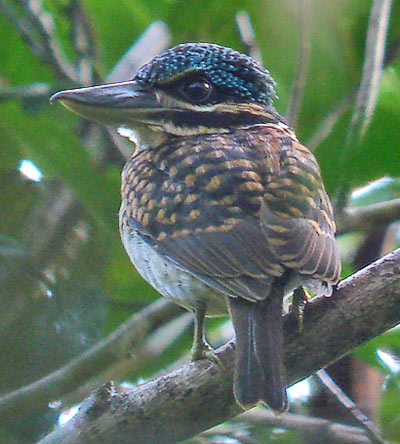
Melidora macrorrhina
SUBFAMILY
Halcyoninae
TAXONOMY
Dacelo macrorrhinus Lesson, 1827, Manokwari, New Guinea.
Three subspecies.
OTHER COMMON NAMES
French: Martin-chasseur d’Euphrosine; German: Hakenliest;
Spanish: Martin Cazador Ganchudo.
PHYSICAL CHARACTERISTICS
11 in (27 cm), 3.1–3.9 oz (90–110 g). Large kingfisher, brown
above and white (male) or buff (female) below. Feathers of
crown are black with blue (male) or green (female) edges. Long
bill has hooked tip with dark brown above and pale below.
DISTRIBUTION
New Guinea and some adjacent small islands.
HABITAT
Lowland rainforest, both primary and secondary, and also agricultural
plantations.
BEHAVIOR
Calls at dusk, dawn, and throughout moonlit nights; one to
three whistles followed by one to four short, high-pitched
notes. Bill often is caked with mud.
FEEDING ECOLOGY AND DIET
Feeds on large insects and frogs, probably by digging in soil.
Main activity is at twilight and during the night.
REPRODUCTIVE BIOLOGY
5 in (12 cm) wide nest chamber dug into active nests of
arboreal termites. Lays two to three eggs; male incubates eggs
and broods chicks by day. Collect food for chicks by day and
night.
CONSERVATION STATUS
Not threatened, but little known due to its nocturnal habits.
SIGNIFICANCE TO HUMANS
None known. Attractive to bird-watching tourists.
Photo Gallery of - Hook-billed kingfisher




 Animalia Life
Animalia Life